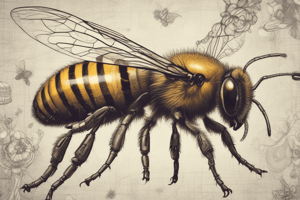Podcast
Questions and Answers
What is the function of the clypeus in the head of a worker bee?
What is the function of the clypeus in the head of a worker bee?
- Helping them groom themselves
- Allowing them to see ultraviolet light
- Serving as a reproductive organ
- Acting as a shield against predators (correct)
Where are the compound eyes located on a honeybee?
Where are the compound eyes located on a honeybee?
- Thorax
- Abdomen
- Head (correct)
- Legs
Which body part of a bee has a small hook called tibial spur for grooming?
Which body part of a bee has a small hook called tibial spur for grooming?
- Thorax (correct)
- Head
- Abdomen
- Wings
What is the purpose of the waxy layer on the abdomen segments of bees?
What is the purpose of the waxy layer on the abdomen segments of bees?
What are the wings of honeybees made up of?
What are the wings of honeybees made up of?
How many pairs of wings do bees have?
How many pairs of wings do bees have?
Flashcards are hidden until you start studying
Study Notes
Bee Anatomy and Physiology
Bee anatomy and physiology may seem complex due to their intricate behavior patterns. However, understanding these aspects can offer insights into their social structure and work ethic. Here's a breakdown of various parts of a honeybee, focusing on the head, thorax, abdomen, wings, stinger, and legs.
Head
The head of a worker bee consists of two main segments: the clypeus and the labrum. These structures serve protective functions, with the clypeus acting as a shield against predators. Additionally, there is a pair of compound eyes located on either side of the head, which allow them to see ultraviolet light used for navigation purposes.
Thorax
Bees have three pairs of legs attached to their thorax. Two pairs of wings are also connected to this segment, allowing them to fly gracefully through the air. The right foreleg has a small hook called tibial spur, which helps them groom themselves by catching debris from their bodies.
Abdomen
The abdomen contains eight hexagonal segments fused together. Each segment has a waxy layer known as terga and sternites, providing protection and waterproofing. In addition to these features, the last segment acts as a reproductive organ in males and females, except for worker bees.
Wings
The wings of the honeybee are made up of two overlapping membranes called pteromeres. These membranes are supported by veins that span the wings. The veins are connected to the thoracic muscles, allowing them to flap and generate lift.
Stinger
Female honeybees possess a stinger, a modified ovipositor, which is used for defense against predators. When a bee stings, the barbed stinger injects venom into the victim, causing pain and irritation. Unfortunately, after stinging once, the bee dies due to the loss of the stinger and its associated muscles.
Legs
The legs of the honeybee consist of six segments: the coxa, trochanter, femur, tibia, tarsus, and pretarsus. These legs are used for walking, climbing, and carrying pollen.
In summary, understanding the anatomy and physiology of bees can help us appreciate their complex behavior and the essential role they play in our ecosystem.
Studying That Suits You
Use AI to generate personalized quizzes and flashcards to suit your learning preferences.




